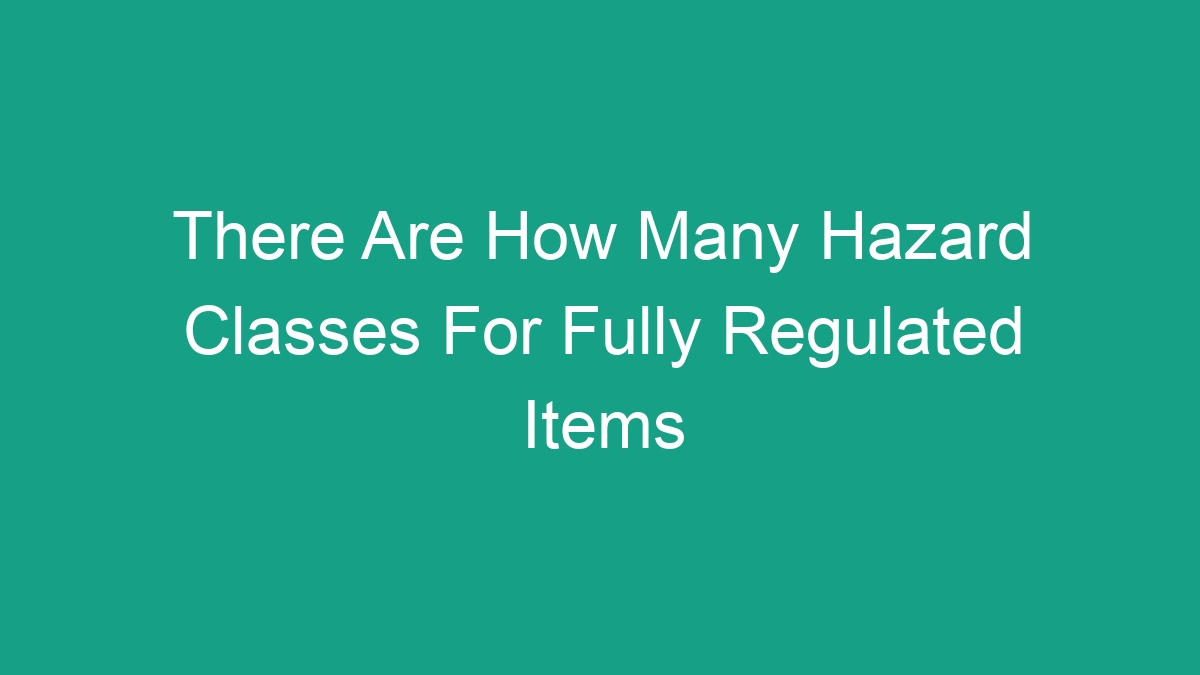
When it comes to the transportation and handling of hazardous materials, it’s crucial to understand the various hazard classes that these items fall into. Whether you work in a regulated industry or simply want to be informed about potential risks, knowing how many hazard classes exist for fully regulated items is essential for safety and compliance.
Understanding Hazard Classes
The United Nations has established a system for classifying hazardous materials based on their physical and chemical properties. These materials are grouped into hazard classes and packing groups, which help to determine the appropriate safety measures for handling, storing, and transporting them.
In the United States, the Department of Transportation (DOT) follows this classification system and has developed regulations for the transportation of hazardous materials. These regulations apply to all modes of transportation, including air, rail, road, and water.
How Many Hazard Classes Are There?
For fully regulated items, there are a total of nine hazard classes that have been established by the DOT. Each class represents a different type of hazard and requires specific precautions to mitigate the risks associated with handling and transportation.
These hazard classes are as follows:
| Hazard Class | Description |
|---|---|
| Class 1: Explosives | Materials and devices that can explode or release energy suddenly and violently. |
| Class 2: Gases | Gaseous materials that are flammable, non-flammable, or toxic. |
| Class 3: Flammable Liquids | Liquids that can easily catch fire and sustain combustion. |
| Class 4: Flammable Solids | Solids that are easily combustible and can ignite through friction or moisture. |
| Class 5: Oxidizing Agents and Organic Peroxides | Substances that can cause or enhance the combustion of other materials. |
| Class 6: Toxic and Infectious Substances | Materials that can cause harm through exposure or contact. |
| Class 7: Radioactive Materials | Materials that emit radiation and pose a risk to human health. |
| Class 8: Corrosive Substances | Materials that can cause severe damage to living tissue or other materials. |
| Class 9: Miscellaneous Hazardous Materials | Materials that pose a hazard during transportation but do not fit into the other classes. |
Additional Considerations
In addition to the hazard classes, the DOT also assigns packing groups to certain hazardous materials. Packing groups further classify the level of risk associated with a particular material, with Group I representing the highest level of danger and Group III representing the lowest.
Furthermore, some hazardous materials may fall into multiple hazard classes, depending on their properties and potential risks. It’s crucial for shippers and handlers to thoroughly understand the classification of the materials they are working with and to implement the appropriate safety measures accordingly.
Regulatory Compliance
Complying with the DOT’s regulations for the transportation of hazardous materials is not only a legal requirement, but also a critical safety consideration. Failure to adhere to these regulations can result in severe penalties and, more importantly, can lead to serious accidents and environmental damage.
Shippers and handlers of hazardous materials must ensure that they are properly trained and equipped to handle these materials safely. This includes understanding the hazard classes, packing groups, and any special provisions that may apply to specific materials.
Training and Certification
For individuals who work with hazardous materials, obtaining the necessary training and certification is imperative. There are specific training requirements outlined by the DOT for hazmat employees, including initial training, recurrent training, and specific function training.
Training courses cover topics such as hazmat identification, packaging, labeling, marking, placarding, and documentation. Additionally, employees must be familiar with emergency response procedures and the use of personal protective equipment.
It’s important to note that training requirements may vary depending on the specific roles and responsibilities of employees within an organization. However, all individuals involved in the transportation and handling of hazardous materials should have a thorough understanding of the regulations and best practices for maintaining safety and compliance.
Conclusion
Understanding the hazard classes for fully regulated items is essential for ensuring the safe and compliant transportation of hazardous materials. With nine distinct hazard classes and additional considerations such as packing groups, it’s crucial for individuals and organizations to be well-versed in these classifications. By prioritizing training, certification, and ongoing education, stakeholders can mitigate the risks associated with hazardous materials and contribute to a safer working environment for everyone involved.
Compliance with the DOT’s regulations not only protects individuals and the environment, but also promotes efficiency and reliability in the transportation of these essential materials.
By staying informed and upholding the highest safety standards, all parties involved can contribute to the responsible and effective management of hazardous materials within their respective industries.



